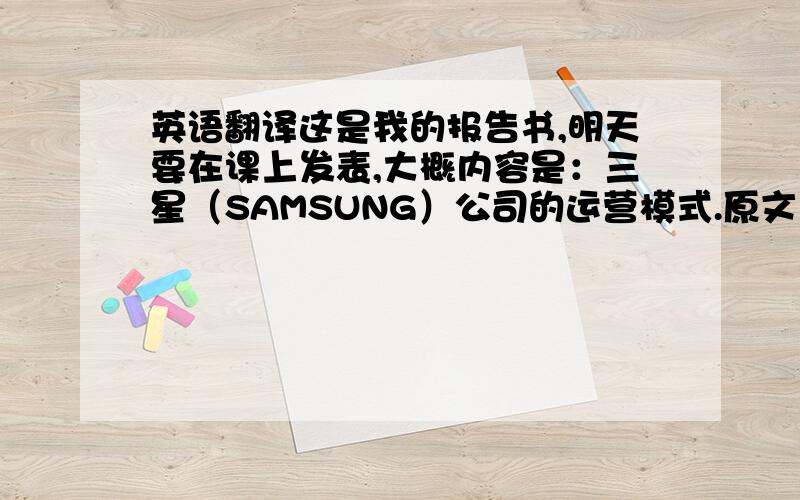英语翻译这是我的报告书,明天要在课上发表,大概内容是:三星(SAMSUNG)公司的运营模式.原文:从研究三星的案例发现一
来源:学生作业帮 编辑:神马作文网作业帮 分类:英语作业 时间:2024/11/11 11:24:40
英语翻译
这是我的报告书,明天要在课上发表,大概内容是:三星(SAMSUNG)公司的运营模式.
原文:
从研究三星的案例发现一个现象,举个例子来说,三星公司把(它生产的)半导体一半是卖给自己的公司.请看下面这个图形,它卖给自己公司的比例从30%到最近的50%,平均是40%.通过图表我们可以看到,三星将一半的产品卖给自己,从而形成了一个内部市场.那么,请大家想一想,三星将半导体产品卖给自己有什么好处呢?我的理解是,三星将半导体不仅卖给外部市场,而且也卖给自己(的公司),从而形成庞大的市场.从这里我们就可以看到它成功的关键所在,三星可以利用这种庞大市场的优势,可以更快的比任何一个竞争对手达到 “规模经济”,规模经济的定义是:The increase in efficiency of production as the number of goods being produced increases
当达到规模经济,通过大量生产达到成本大幅下降,这种好处是非常惊人的.为了证明我的观点,请看下面的图表,我拿三星的蓝紫两条线来说明,紫线代表的是net sales ,蓝线代表的是Seling cost,我们发现net sales的成长率远远高于Seling cost的成长率,这是非常罕见的现象.因为即便包括像 Nokia 这样经营很好的公司,它net sales 的成长率也不过是和Seling cost 持平,能够做到这样,就算是很好的情况了.相比较其它的企业而言,我们不难发现,一个企业扩张以后,(这个企业的)net sales往往就会超过Seling cost的增长,从而导致资产回报率下降.造成这种情况的原因就是成本失控.
最后,让我们再总结一下前面提到的内容.三星建立了一套垂直整合体系(Vertical Intergration) ,这样一套系统工程的有效运行的结果就是:三星不是单纯以半导体来盈利,而是它有后续市场在创造价值,所以它的资本回报率超过它的同行业.另外,三星又有庞大的市场,所以,它比竞争对手更快的达到规模经济,从而降低成本 .
以上是我们的报告书,
可以只翻译第一段.
用机器翻译的朋友就不用费心了 ,好意心领了 .
这是我的报告书,明天要在课上发表,大概内容是:三星(SAMSUNG)公司的运营模式.
原文:
从研究三星的案例发现一个现象,举个例子来说,三星公司把(它生产的)半导体一半是卖给自己的公司.请看下面这个图形,它卖给自己公司的比例从30%到最近的50%,平均是40%.通过图表我们可以看到,三星将一半的产品卖给自己,从而形成了一个内部市场.那么,请大家想一想,三星将半导体产品卖给自己有什么好处呢?我的理解是,三星将半导体不仅卖给外部市场,而且也卖给自己(的公司),从而形成庞大的市场.从这里我们就可以看到它成功的关键所在,三星可以利用这种庞大市场的优势,可以更快的比任何一个竞争对手达到 “规模经济”,规模经济的定义是:The increase in efficiency of production as the number of goods being produced increases
当达到规模经济,通过大量生产达到成本大幅下降,这种好处是非常惊人的.为了证明我的观点,请看下面的图表,我拿三星的蓝紫两条线来说明,紫线代表的是net sales ,蓝线代表的是Seling cost,我们发现net sales的成长率远远高于Seling cost的成长率,这是非常罕见的现象.因为即便包括像 Nokia 这样经营很好的公司,它net sales 的成长率也不过是和Seling cost 持平,能够做到这样,就算是很好的情况了.相比较其它的企业而言,我们不难发现,一个企业扩张以后,(这个企业的)net sales往往就会超过Seling cost的增长,从而导致资产回报率下降.造成这种情况的原因就是成本失控.
最后,让我们再总结一下前面提到的内容.三星建立了一套垂直整合体系(Vertical Intergration) ,这样一套系统工程的有效运行的结果就是:三星不是单纯以半导体来盈利,而是它有后续市场在创造价值,所以它的资本回报率超过它的同行业.另外,三星又有庞大的市场,所以,它比竞争对手更快的达到规模经济,从而降低成本 .
以上是我们的报告书,
可以只翻译第一段.
用机器翻译的朋友就不用费心了 ,好意心领了 .

A phenomenon can be noticed in the case study of Samsung. For instance, Samsung sold half of its semiconductors to its subsidiaries. Please take a look at the graph below, which shows that the proportion of buying its own products has increased from 30% to the current 50%, averaging at 40%. We can see from the graph that Samsung establishes an internal market by selling its products to itself. So, just think why Samsung buys its own semiconductors? In my opinion, it gets a huge market by selling products to both external and internal markets. Now we can see its key to success, that is, Samsung can take advantage of its huge market, and in this way, it can achieve "Economy of Scale" earlier than any of its competitors. The definition of "Economy of Scale" is that the increase in efficiency of production as the number of goods being produced increases
When it reaches economy of scale, the result is extremely rewarding, as the cost will be greatly reduced as a result of mass production. To better illustrate my point, I would like to ask you to have a look at the diagram below. You can see two lines here, the purple one stands for Selling cost, while the blue one stands for net sale. Because even for a well-operated company like Nokia, the net sales and selling cost are just leveled off. In fact, this has already been a good sign. Compared with different companies, it is easy to tell that the growth of its net sales tend to exceed that of its selling cost after the expansion of a company, resulting in a drop on its return on asset. And the reason for this is runaway costs.
All in all, let's sum up what was mentioned just now. Samsung has established a system of Vertical Intergration, and the effective operating of this system turns out to be very rewarding: Samsung does not simply make a profit on its semiconductor, its follow-up market is createing even more value instead.Therefore, its return on capital takes an industry-leading position. Moreover, Samsung also enjoys a huge market, which enables it to reach economy of scale more easily than its competitors, hence cutting the cost.
That's all for our report. Thank you for listening.
When it reaches economy of scale, the result is extremely rewarding, as the cost will be greatly reduced as a result of mass production. To better illustrate my point, I would like to ask you to have a look at the diagram below. You can see two lines here, the purple one stands for Selling cost, while the blue one stands for net sale. Because even for a well-operated company like Nokia, the net sales and selling cost are just leveled off. In fact, this has already been a good sign. Compared with different companies, it is easy to tell that the growth of its net sales tend to exceed that of its selling cost after the expansion of a company, resulting in a drop on its return on asset. And the reason for this is runaway costs.
All in all, let's sum up what was mentioned just now. Samsung has established a system of Vertical Intergration, and the effective operating of this system turns out to be very rewarding: Samsung does not simply make a profit on its semiconductor, its follow-up market is createing even more value instead.Therefore, its return on capital takes an industry-leading position. Moreover, Samsung also enjoys a huge market, which enables it to reach economy of scale more easily than its competitors, hence cutting the cost.
That's all for our report. Thank you for listening.
英语翻译这是我的报告书,明天要在课上发表,大概内容是:三星(SAMSUNG)公司的运营模式.原文:从研究三星的案例发现一
“SAMSUNG”是三星手机的标志吗?
三星的Samsung Recovery Solution 3 是怎么制作的
英语翻译是三星手机包装盒上的
请问有那个英语老师能帮我翻译一下这段话(不用翻译器)急要,谢谢! 三星公司: 三星集团是韩国最大的
三星贴片电容怎么区别原装三星电容呢?我发现我们现在拿的三星电容好多都氧化了,估计是假的,三星电容中国这边有没有代理商之类
英语翻译急,是关于三星传真机上的!再问一下三星3100传真机换墨盒按什么键?
三星堆的文化发现地是哪
请问三星手机中的,More Services S Suggest Samsung Apps 这三个软件都是干什么的?
英语翻译三星公司:三星集团是韩国最大的企业集团,包括26个下属公司及若干其他法人机构,在近70个国家和地区建立了近300
三星手机的英语翻译在哪找
三星笔记本上的Easy Display Manager是干什么的?